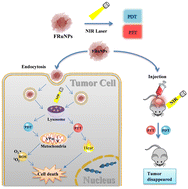Single laser activated photothermal/photodynamic dual-modal cancer phototherapy by using ROS-responsive targeting flower-like ruthenium nanoparticles
Abstract
Phototherapy, which mainly includes photothermal therapy (PTT) and photodynamic therapy (PDT), is one of the most promising strategies for cancer therapeutics. Ruthenium as a metal nanomaterial shows great potential as a phototherapy agent. Herein, we developed flower-like ruthenium nanoparticles (FRuNPs) to enhance cancer phototherapy. Compared with spherical ruthenium nanoparticles (SRuNPs) of a similar size, FRuNPs exhibited more enhanced near-infrared (NIR) absorption. FRuNPs exhibited a superior photothermal effect, which significantly improved the efficiency of PTT. Intracellular reactive oxide species (ROS) generation was recognized as the primary mechanism of PDT treatment. FRuNPs mediated the generation of ROS when exposed to 808 nm laser irradiation. Moreover, with the synergistic effect of PTT and PDT in FRuNPs, the phototherapeutic effects were obviously enhanced. In vitro phototherapy of MCF-7 cells in the presence of FRuNPs led to nearly 100% cell death under irradiation with an 808 nm laser. And in vivo FRuNPs further showed the capacity of in completely clearing the tumor tissues and improving the hypoxia environment with 14 days for interval laser irradiation. These results indicate that FRuNPs have versatile potential for tumor phototherapy.

- This article is part of the themed collection: Journal of Materials Chemistry B HOT Papers


 Please wait while we load your content...
Please wait while we load your content...